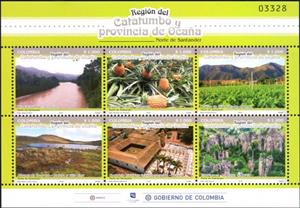Mini Sheet: Views of the Catatumbo Region (Colombia 2018)
Views of the Catatumbo Region (Colombia 2018)
17 August (Colombia ) within release Views of Catatumbo Region and Ocaña Province goes into circulation Mini Sheet Views of the Catatumbo Region face value 6*1000 Colombian peso
| Mini Sheet Views of the Catatumbo Region in catalogues | |
|---|---|
| Colnect codes: | Col: CO 2018-18 |
Mini Sheet is square format.
Numbered mini sheet of six stamps. Printed by Cartor Security Printing. Each stamp measures 40x30 mm.Also in the issue Views of Catatumbo Region and Ocaña Province:
- Mini Sheet - Views of the Catatumbo Region face value 6*1000;
- Stamp - Catatumbo River face value 1,000;
- Stamp - Gran Convención Historical Complex, Ocaña face value 1,000;
- Stamp - Kidney Bean (Phaseolus vulgaris) face value 1,000;
- Stamp - Los Estoraques Unique Natural Area face value 1,000;
- Stamp - Páramo de Guerrero face value 1,000;
- Stamp - Pineapples (Ananas comosus) face value 1,000;
Mini Sheet Views of the Catatumbo Region it reflects the thematic directions:
In botany, a fruit is the seed-bearing structure in flowering plants (also known as angiosperms) formed from the ovary after flowering. Fruits are the means by which angiosperms disseminate seeds. Edible fruits, in particular, have propagated with the movements of humans and animals in a symbiotic relationship as a means for seed dispersal and nutrition; in fact, humans and many animals have become dependent on fruits as a source of food. Accordingly, fruits account for a substantial fraction of the world's agricultural output, and some (such as the apple and the pomegranate) have acquired extensive cultural and symbolic meanings. In common language usage, "fruit" normally means the fleshy seed-associated structures of a plant that are sweet or sour, and edible in the raw state, such as apples, bananas, grapes, lemons, oranges, and strawberries. On the other hand, in botanical usage, "fruit" includes many structures that are not commonly called "fruits", such as bean pods, corn kernels, tomatoes, and wheat grains. The section of a fungus that produces spores is also called a fruiting body.
A landscape is the visible features of an area of land, its landforms and how they integrate with natural or man-made features. A landscape includes the physical elements of geophysically defined landforms such as (ice-capped) mountains, hills, water bodies such as rivers, lakes, ponds and the sea, living elements of land cover including indigenous vegetation, human elements including different forms of land use, buildings and structures, and transitory elements such as lighting and weather conditions. Combining both their physical origins and the cultural overlay of human presence, often created over millennia, landscapes reflect a living synthesis of people and place that is vital to local and national identity. The character of a landscape helps define the self-image of the people who inhabit it and a sense of place that differentiates one region from other regions. It is the dynamic backdrop to people’s lives. Landscape can be as varied as farmland, a landscape park, or wilderness. The earth has a vast range of landscapes, including the icy landscapes of polar regions, mountainous landscapes, vast arid desert landscapes, islands and coastal landscapes, densely forested or wooded landscapes including past boreal forests and tropical rainforests, and agricultural landscapes of temperate and tropical regions.
A river is a natural freshwater stream that flows on land or inside caves towards another body of water at a lower elevation, such as an ocean, lake, or another river. A river may run dry before reaching the end of its course if it runs out of water, or only flow during certain seasons. Rivers are regulated by the water cycle, the processes by which water moves around the Earth. Water first enters rivers through precipitation, whether from rainfall, the runoff of water down a slope, the melting of glaciers or snow, or seepage from aquifers beneath the surface of the Earth.
In the visual arts, a cityscape (urban landscape) is an artistic representation, such as a painting, drawing, print or photograph, of the physical aspects of a city or urban area. It is the urban equivalent of a landscape. Townscape is roughly synonymous with cityscape, though it implies the same difference in urban size and density (and even modernity) implicit in the difference between the words city and town. In urban design the terms refer to the configuration of built forms and interstitial space.



